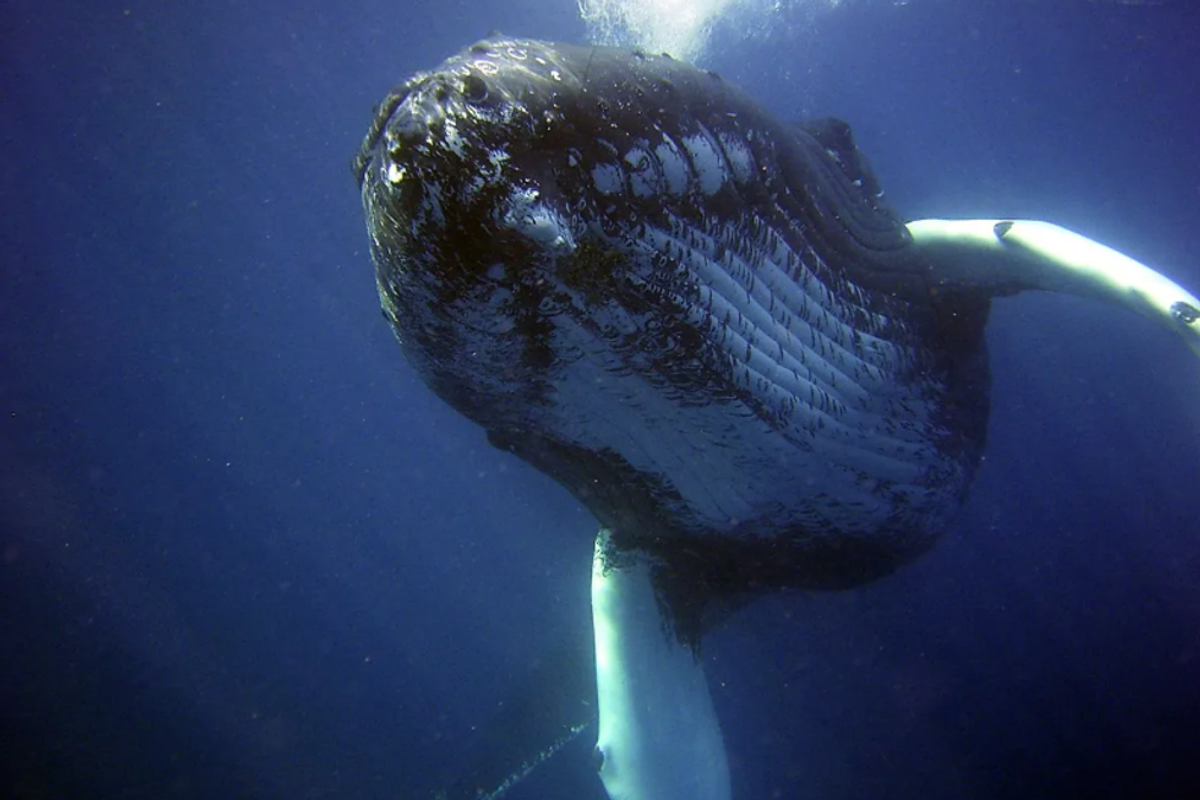The oldest whales in the ocean were alive before 'Moby-Dick' and have the harpoons to prove it
These gentle giants have lived through history.
A humpback whale swimming.
You're probably familiar with the literary classic Moby-Dick by the great Herman Melville. But in case you're not, here's the gist: first published in 1851, Moby Dick is about an enraged sea captain in pursuit of a huge, ancient albino sperm whale, Moby-Dick. There sea captain is called Captain Ahab, and he really really hates the whale. In fact, he goes absolutely bonkers in his quest to hunt and kill it, and then everything is awful and we all die unsatisfied with our shared sad existence and—oops, spoilers!
OK, technically, the narrator, Ishmael, survives, so there's somewhat of a happy ending. We also learn a lot of lessons in the end about life, chowder (clam or cod? It's a metaphor), and co-existing on this planet with our fellow animals. It's one of the most famous (and most referenced) works of literature in history (As evidenced below. Oh, Homer...).
- YouTube youtu.be
Essentially, the book is about revenge and obsession. It's also chock-full of beautiful passages and dense symbolism and deep thematic resonance, and all those good things that earned it a top spot in the musty canon of important literature. There's also a lot of mundane descriptions about the whaling trade as well (like, a lot). That's because it came out back when commercial whaling was still a thing.

In fact, humans used to hunt more than 50,000 whales each year to use for oil, meat, baleen, and more oil. Then, in 1946, the International Whaling Commission stepped in and said, "Hey, wait a minute, guys. There's only a few handful of these majestic creatures left in the entire world, so maybe we should try to not kill them anymore?"
And even then, commercial whaling was still legal in some parts of the world until as recently as 1986.
And yet, by some miracle, there are whales who were born before Moby-Dick was published that are still alive today
What are the odds of that? Honestly, it's hard to calculate since we can't exactly swim up to a bowhead and say, "Hey, how old are you?" and expect a response. (Also, that's a rude question—jeez.)
Thanks to some thoughtful collaboration between researchers and traditional Inupiat whalers (who are still allowed to hunt for survival) over the decades, scientists have used amino acids in the eyes of whales and harpoon fragments lodged in their carcasses to determine the age of these enormous animals. In 2006, they found at least three bowhead whales who were living prior to 1850. Granted those are bowheads, not sperm whales like the fictional Moby Dick, (and none of them are albino, I think), but still. Pretty amazing, huh?
Bowhead whales reach an average length of 35 to 45 feet, and they are believed to live over 200 years. One of the big reasons for their longevity is that they have genes that may allow for the repair of damaged DNA. Researchers believe that the bowhead is the whale with the longest lifespan. Baleen whales have been found to live longer than toothed cetaceans such as the sperm whale or orca.

This is a particularly remarkable feat considering that the entire species was dwindling near extinction
Barring these few centenarian leviathans, most of the whales still kickin' it today are between 20 and 70 years old. That's because most whale populations were reduced to 10% or less of their numbers between the 18th and 20th centuries, thanks to a few over-eager hunters (and by a few, I mean all of them).
Today, sperm whales are considered one of the most populous species of massive marine mammals. Bowheads, on the other hand, are still in trouble despite a 20% increase in population since the mid-1980s. Makes those few elderly bowheads that much more impressive, huh?

Unfortunately, just as things are looking up, these wonderful whales are in trouble once again
We might not need to worry about real-life Captain Ahabs anymore, but our big aquatic buddies are still being threatened by industrialization—namely, from oil drilling in the Arctic and the Great Australian Bight, though efforts are being made to ban oil drilling in these and other areas.
In the off-chance that companies like Shell and BP manage not to spill millions of gallons of harmful crude oil into the water, the act of drilling alone is likely to maim or kill millions of animals, and the supposedly-safer sonic blasting will blow out their eardrums or worse.
This influx of industrialization also affects their migratory patterns—threatening not only the humans who depend on them, but also the entire marine ecosystem.

Whales might be large and have remarkable longevity, but they still need our help to survive
If you want another whale to make it to his two-hundredth birthday and beyond (which you should because I hear they throw great parties), then sign these petitions via Change.org to protect our oceans from oil drilling, ship strikes, and other other industrial threats.
I guarantee Moby Dick will appreciate it.
This article originally appeared ten years ago. It has been updated.

